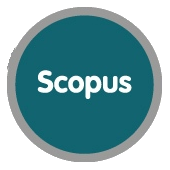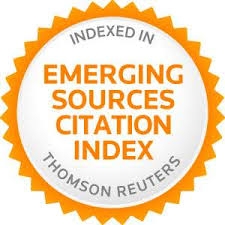Iconicidad y metáfora en el lenguaje chileno de signos (LENSE): un análisis cualitativo
Resumen
Palabras clave
Texto completo:
PDFReferencias
Anderson, P., Meyer, A., Eisenhardt, K., Carley, K., Pettigrew, A. (1999). Introduction to the special issue: Application of complexity theory to organization science. Organization Science, 10, 233 -236.
http://dx.doi.org/10.1287/orsc.10.3.233
Andrade, S., Shelding, M., Boville, E. (1987) Métodos cualitativos para la investigación. The Pathfield Fundation. Wateton.
Armstrong, D., Stokoe, W. & . Wilcox, S(1994). Signs of the origin of syntax. Curr. Anthropol., 35, 349–368.
http://dx.doi.org/10.1086/204290
Armstrong, D., Stokoe, W.& Wilcox, S. (1995). Gesture And the Nature of Lan-guage. Cambridge University Press.
http://dx.doi.org/10.1017/CBO9780511620911
Avalos, E., Cuevas, H., y Pilleux, M. (1991). El lenguaje de se-as. Análisis sintáctico-semántico. Santiago: Universidad Austral de Chile.
Awh, E., Jonides, J., Smith, E.E., Buxton, R.B., Frank, L.R., Love, T., Wong, E.C., & Gmeindl, L. (1999). Rehearsal in spatial working memory: Evidence from neuroimaging. Psychological Science, 10, 433-437.
http://dx.doi.org/10.1111/1467-9280.00182
Beer, R. (1995). A dynamical systems perspective on agent-environment interaction. Artificial Intelligence, 72 , 173-215.
http://dx.doi.org/10.1016/0004-3702(94)00005-L
Bickerton, D. (1990). Language and Species. Chicago: University of Chicago Press.
Boyes, P. (1998). Culturally determined or free gestures? The perception of gestures by members of different hearing and deaf cultures. In Fähndrich, W. (Ed.) Improvisation III Amadeus
Brennan, M (1992) The Visual World of BSL: An Introduction. Dictionary of British Sign Language/English, London and Boston: Faber & Faber 1-133.
Brennan, M (1994) Pragmatics and Productivity; in: Ahlgren, I, Bergman, B & Brennan, M (eds) Perspectives on Sign Language Usage: Papers from the Fifth International Symposium on Sign Language Research, Vol 2; Durham: International Sign Linguistics Association
Brigthon, H., Smith, K., Kirby, S. (2003). Situated cognition and the role of multi-agent models in explaining language structure. In D. Kudenko, E. Alonso, and D. Kazakov (Eds.) Adaptive agents and multi-agent systems: adaptation and multi-agent Learning. Springer
http://dx.doi.org/10.1007/3-540-44826-8_6
Browman, C.& Goldstein, L. (1989). Articulatory gestures as phonological units. Pho-nology, 6: 201–251.
http://dx.doi.org/10.1017/S0952675700001019
Chamberlain, J. Morford, J., Mayberry, R. (2000) Language acquisition by eye . NJ: Lawrence Erlbaum Associates.
Chomsky, N. (1966). Cartesian Linguistics. NY: Harper & Row.
Clark, A. (2001) Reasons, robots and the extended mind. Mind and languaje, 16, 121-145.
http://dx.doi.org/10.1111/1468-0017.00162
Coates, F.(2002) Exploiting minimally embodied cognition. Evolutionary systems, 4, 78-71.
Court de Gebelin, M (1774) Universal Grammar, in Desloges, P., A Deaf Person's Observations about an Elementary Course of Education for the Deaf in Lane, H (ed) (1984) The Deaf Experience. Cambridge: Harvard University Press
Dourish, P.(2001). Where the Action Is: the Foundations of Embodied Interaction. MIT Press.
Edelman, G. (1987). Neural Darwinism: The Theory of Neuronal Group Selection. NY: Basic Books.
Emmorey, K (2004) Visual imaginery and cognition. NY: basic Books.
Emmorey, K. & Kosslyn, D. (2002) Mental imagery and embodied cognition. Journal of mental imagery, 26, 50-53.
Engeström, I. (1991). Activity theory and social transformation. Multidisiplinary newsletter for activity theory, 7, 6-17.
Fauconnier, G., Turner, M. (2002) The Way We Think: Conceptual Blending and the Mind's Hidden Complexities. New York: Basic Books.
Faurot, K., Dellinger, D., Eatough, A., and Parkhurst, S. (2001) The Identity of Mexican Sign as a Language. Jor Cog ling, 23, 567-589.
Gentner, D. (2001). Spatial Metaphors in Temporal Reasoning. (203-222). In M. Gattis (Ed.) Spatial Schemas and Abstract Thought. Cambridge: MIT Press.
Gibss, R. (2000) Intentions in the Experience of Meaning, Cambridge, UK and New York, NY: Cambridge University Press, 1999.
Giuranna, R. & Giuranna, G. (2002). Poetis structures in ASL and LIS. Institute of Psychology, National Research Council (CNR), Rome.
Goldin-Meadow, S., Nusbaum, H., Kelly, S., & Wagner, S. (2001). Explaining Math: Gesturing Lightens the Load. Psychological Science, 12, 516-522.
http://dx.doi.org/10.1111/1467-9280.00395
Goodwin, C. (2000). Gesture, aphasia, and interaction. (84-98). In McNeill, D. (Ed.), Language and Gesture New York: Cambridge.
Haugeland, J. (1995). Having Thought: essays in the metaphysics of mind. Harvard University Press.
Jackendoff, R. (1990). Semantic Structures. Cambridge, MA: MIT Press.
Jackendoff, R. (1999) The architecture of the language faculty. Cambridge, MA: MIT Press.
Jakendoff, R. (2002) Foundations of Language. Oxford: Oxford University Press.
http://dx.doi.org/10.1093/acprof:oso/9780198270126.001.0001
Johnson, M. (1987). The Body in the Mind, Chicago: University of Chicago Press
Johnson, T (1991) Spatial Syntax and Spatial Semantics in the Inflection of Signs for the Marking of Person and Location. International Journal of Sign Linguistics, 23, 45-59
Johnston, T (1996) Function and Medium in the Forms of Linguistic Expression Found in a Sign Language. International Review of Sign Linguistics, 1, 57-94
Kelly, S.D., Barr, D.J., Church, R.B., & Lynch, K. (1999). Offering a hand to pragmatic understanding: The role of speech and gesture in comprehension and memory. Journal of Memory and Language, 40, 577-592.
http://dx.doi.org/10.1006/jmla.1999.2634
Kelso, J., Saltzman, t., & Tuller, M. (1986). The dynamical perspective on speech production: data and theory. J. Phonetics, 14: 29–59.
Kirsh, D. 1995. The intelligent use of space. Artificial Intelligence 73:31-68.
http://dx.doi.org/10.1016/0004-3702(94)00017-U
Klima, E. S. & Bellugi, U. (1976). Poetry and song in a language without sound, Cognition, 4, 45-97.
http://dx.doi.org/10.1016/0010-0277(76)90010-X
Klima, S., Bellugi, U.(1988) Sign language and the brain (48-69). In: Plum, Fred (ed): Language, communication, and the brain. New York : Raven Pr.
Lakoff G. & Johnson M. (1998), Philosophy in the Flesh : The Embodied Mind and Its Challenge to Western Thought. NY: Basic Books.
Lakoff, G & Johnson, M (1980) Metaphors We Live By. Chicago and London: University of Chicago Press.
Lakoff, G & Turner, M. (1998) More than cool rasons: A fiel guide to poetic metaphor. Presise. Paperback. NY.
Lakoff, G. & Nú-ez, R. (2000). Where Mathematics Comes From: How the Embodied Mind Brings Mathematics into Being (chapter 3, pp. 50-76). New York: Basic Books
Lave, J. (1988). Cognition in practice. Cambridge, UK: Cambridge University Press.
http://dx.doi.org/10.1017/CBO9780511609268
Lyn, R., Stein, F. (1991). Imaginated and situated cognition. MIT press.
Marschark, M. & Clark, M. D., Editors, (1998). Psychological perspectives on deafness. Mahwah: Lawrence Erlbaum and Associates. NY.
McNeill, D (1992) Hand and Mind What Gestures Reveal about Thought. Chicago, University of Chicago Press
McNeill, D. (2000). Language and Gesture. Cambridge: Cambridge University Press
http://dx.doi.org/10.1017/CBO9780511620850
McNeill, D. (2002). Gesture and language dialectic. Acta Lingüística, 23 124-154.
McNeill, D. y Duncan, S. D. (2000). Growth points in thinking-for-speaking. En D. McNeill (ed.), Language and gesture, pp. 141-161. Cambridge: University Press.
McNeill, D., Quek, F., McCullough, K.-E, Duncan, S., Furuyama, N., Bryll, R., Ma, X.-F., & Ansari., R. (in press). Dynamic Imagery in Speech and Gesture. In B. Granström, D. House and I. Karlsson (Eds.) Multimodality in Language and Speech Systems. Dordrecht, The Netherlands: Kluwer Academic Pulblishers
Neidle, D. MacLaughlin, B. Bahan, and J. Kegl (1999) Role Shift in ASL: A Syntactic Look at Direct Speech. (24-45). In C. Neidle, D. MacLaughlin, and R.G. Lee (eds), Syntactic Structure and Discourse Function: An Examination of Two Constructions in American Sign Language. Boston: Boston University.
Nú-ez, R. (2004). Do Real numbers really move? The embodied cognitive foundations of mathematics. In F. Iida, R. Pfeifer, L. Steels, & Y. Kuniyoshi (Eds.), Embodied Artificial Intelligence, (pp. 54-73). Berlin: Springer-Verlag.
Parasnis, I. (1998). Cultural language diversity and deaf experience. Cambridge: University Press.
Peirce, C.(1955). Logic as Semiotic: The Theory of Signs. In J. Buchler (ed.), Philosophi-cal Writings of Peirce. NY: Dover.
Pinker, S. 1994. The Language Instinct. NY: Morrow.
Pizzuto, E. & Russo, T. (2000). Italian sign languaje (LIS). the Institute of Psychology, National Research Council (CNR), Rome.
Prem, (1996) Elements of an epistemology of embodied AI. Tecnical report GOFAI, 3, 45-58.
Ramsey, W. (1999) Philosophy and connectionist theory. Pragmatics and Cognition, 2, 327-348.
Rivano, E. (2002) Metáfora y lingüística cognitiva. Buenos Aires: Archivos de filología
Rizzolatti, G. & Arbib, M.A. (1998). Language within our grasp. Trends in Neurosciences, 21, 188-194
http://dx.doi.org/10.1016/S0166-2236(98)01260-0
Steinhauer, K., Alter, K., Friederici, A. (1999) Brain potentials indicate immediate use of prosodic cues in natural speech processing. Nature Neuroscience, 2, 191-197.
http://dx.doi.org/10.1038/5757
Suchman, L. 1987. Plans and situated actions. Cambridge, UK: Cambridge University Press.
Supalla, T. (1991) Serial Verbs of Motion in ASL. In: Fischer, S.D. & P. Siple (Eds.) Theoretical Issues in Sign Language Research, pp. 127-62. Chicago: University of Chicago.
Swinney, D., Prather & T. Love (2000). Neurological distribution of processing operations underlying language comprehension. Journal of Cognitive Neuroscience 8, 174-184.
http://dx.doi.org/10.1162/jocn.1996.8.2.174
Taub, S. (2001) Languaje from the body. Cambridge University Press
http://dx.doi.org/10.1017/CBO9780511509629
Thelen, E., Schoner, G., Scheier, G., Smith, L. (2000). The dyanmics of embodiment: A field theory of infant perseverative reaching. Behavioral and brain sciences 6, 13-28.
Varela, F Thompsom, E y Rosch, E. (1991ª). The embodied mind: Cognitive science and human experience. MIT Press, Cambridge, MA, USA.
Wilbur, R. (1989) Metaphors in American Sign Language and English, in Edmondson, WH and Karlsson, F. (eds) Papers from the Fourth International Symposium on Sign Language Researc.h Hamburg: Signum Press
Wilcox, P (1993) Metaphorical Mappings in American Sign Language. Albuquerque: University of New Mexico
Wilcox, S. (1996). Not from Jove's brow. Lang. & Comm., 26: 179–192.
http://dx.doi.org/10.1016/0271-5309(96)00006-7
Wilson, B., Madsen Myers, K. (1999) Situated Cognition in Theoretical and Practical Context. In D. Jonassen & S. Land (Eds.). Theoretical foundations of learning environments. Mahwah NJ: Erlbaum.
Wilson, R. (1994). Wide computationalism. Mind 103, 351-372.
http://dx.doi.org/10.1093/mind/103.411.351
Winter, S. (1998) Expectations and Linguistic Meaning. Lund: Lund University Cognitive Studies.
Enlaces refback
- No hay ningún enlace refback.


